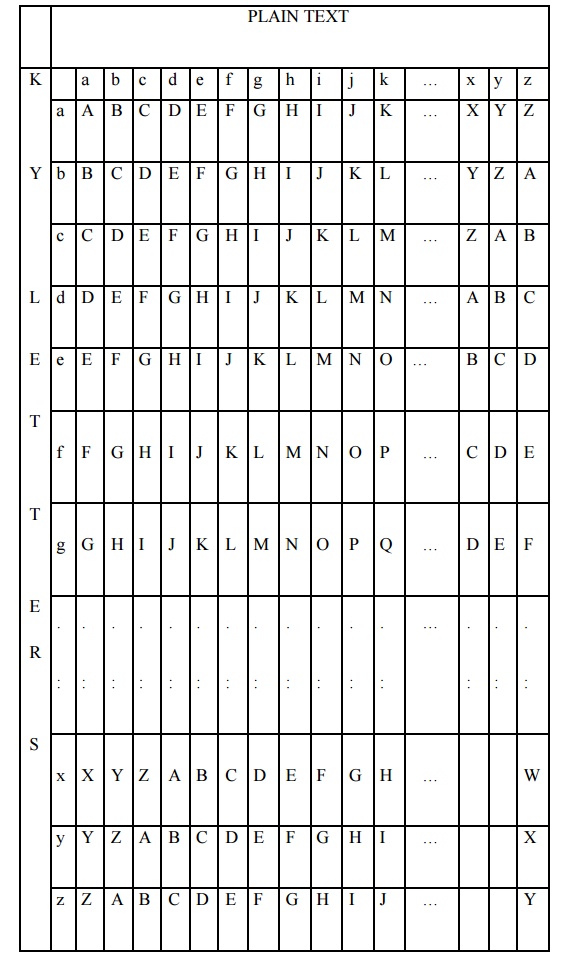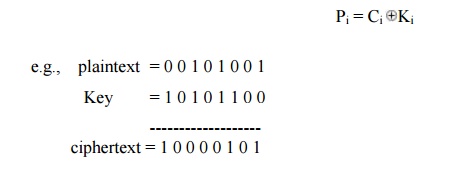Chapter: Cryptography and Network Security
Classical Encryption Techniques
CLASSICAL ENCRYPTION TECHNIQUES
There are two basic building blocks of all encryption techniques: substitution and transposition.
1 SUBSTITUTION TECHNIQUES
A substitution
technique is one in which the letters of plaintext are replaced by other
letters or by numbers or symbols. If the plaintext is viewed as a sequence of
bits, then substitution involves replacing plaintext bit patterns with cipher
text bit patterns.
(i)Caesar cipher (or) shift cipher
The
earliest known use of a substitution cipher and the simplest was by Julius
Caesar. The Caesar cipher involves replacing each letter of the alphabet with
the letter standing 3 places further down the alphabet.
e.g., Plain
text : pay more mone Cipher text: SDB PRUH PRQHB
Note that
the alphabet is wrapped around, so that letter following „z‟ is „a‟. For
each plaintext letter p, substitute the cipher text letter c such that C =
E(p) =
(p+3) mod 26
A shift
may be any amount, so that general Caesar algorithm is C = E (p) = (p+k) mod 26
Where k
takes on a value in the range 1 to 25. The decryption algorithm is simply P =
D(C) = (C-k) mod 26
(ii)Playfair cipher
The best
known multiple letter encryption cipher is the playfair, which treats digrams
in the plaintext as single units and translates these units into cipher text
digrams. The playfair algorithm is based on the use of 5x5 matrix of letters
constructed using a keyword. Let the keyword be „monarchy‟. The
matrix is constructed by filling in the letters of the keyword (minus
duplicates) from left to right and from top to bottom, and then filling in the
remainder of the matrix with the remaining letters in alphabetical order.
The
letter „i‟ and „j‟ count as one letter. Plaintext is encrypted two letters at a time
according to the following rules:
Repeating
plaintext letters that would fall in the same pair are separated with a filler
letter such as „x‟.
Plaintext
letters that fall in the same row of the matrix are each replaced by the letter
to the right, with the first element of the row following the last.
Plaintext
letters that fall in the same column are replaced by the letter beneath, with
the top element of the column following the last.
Otherwise,
each plaintext letter is replaced by the letter that lies in its own row and
the column occupied by the other plaintext letter.

Plaintext
= meet me at the school house
Splitting
two letters as a unit => me et me at th es ch ox ol ho us ex Corresponding
cipher text => CL KL CL RS PD IL HY AV MP HF XL IU
Strength of playfair cipher
Playfair
cipher is a great advance over simple mono alphabetic ciphers.
Since
there are 26 letters, 26x26 = 676 diagrams are possible, so identification of
individual digram is more difficult.
Frequency
analysis is much more difficult.
(iii)Polyalphabetic ciphers
Another
way to improve on the simple monoalphabetic technique is to use different
monoalphabetic substitutions as one proceeds through the plaintext message. The
general name for this approach is polyalphabetic cipher. All the techniques
have the following features in common.
A set of
related monoalphabetic substitution rules are used
A key
determines which particular rule is chosen for a given transformation.
(iv)Vigenere cipher
In this
scheme, the set of related monoalphabetic substitution rules consisting of 26
caesar ciphers with shifts of 0 through 25. Each cipher is denoted by a key
letter. e.g.,
Caesar
cipher with a shift of 3 is denoted by the key value 'd‟ (since
a=0, b=1, c=2 and so on). To aid in understanding the scheme, a matrix known as
vigenere tableau is constructed.
Each of
the 26 ciphers is laid out horizontally, with the key letter for each cipher to
its left. A normal alphabet for the plaintext runs across the top. The process
of encryption is simple: Given a key letter X and a plaintext letter y, the
cipher text is at the intersection of the row labeled x and the column labeled
y; in this case, the ciphertext is V.
To
encrypt a message, a key is needed that is as long as the message. Usually, the
key is a repeating keyword.
e.g., key = d e c e p t i v e d e c e p t i v e d e c e p t i v e
PT = w e a
r e d i s c o v e r e d s a v e y o u r s e l f
CT = ZICVTWQNGRZGVTWAVZHCQYGLMGJ

Decryption
is equally simple. The key letter again identifies the row. The position of the
cipher text letter in that row determines the column, and the plaintext letter
is at the top of that column.
Strength of Vigenere cipher
There are
multiple ciphertext letters for each plaintext letter
Letter
frequency inforamiton is obscured.
One Time Pad Cipher
It is an
unbreakable cryptosystem. It represents the message as a sequence of 0s and 1s.
this can be accomplished by writing all numbers in binary, for example, or by
using ASCII. The key is a random sequence of 0‟s and 1‟s of same
length as the message.
Once a
key is used, it is discarded and never used again. The system can be expressed
as follows:

Thus the
cipher text is generated by performing the bitwise XOR of the plaintext and the
key. Decryption uses the same key. Because of the properties of XOR, decryption
simply involves the same bitwise operation:

Advantage:
Encryption
method is completely unbreakable for a ciphertext only attack.
Disadvantages
It
requires a very long key which is expensive to produce and expensive to
transmit.
Once a
key is used, it is dangerous to reuse it for a second message; any knowledge on
the first message would give knowledge of the second.
2 TRANSPOSITION TECHNIQUES
All the
techniques examined so far involve the substitution of a cipher text symbol for
a plaintext symbol. A very different kind of mapping is achieved by performing
some sort of permutation on the plaintext letters. This technique is referred
to as a transposition cipher.
Rail fence is simplest of such cipher, in
which the plaintext is written down as a sequence of diagonals and then read off as a sequence of rows.
Plaintext = meet at the school house
To
encipher this message with a rail fence of depth 2, we write the message as
follows:
m e a t e c
o l o s
e t t h s H o h u
e
The
encrypted message is
MEATECOLOSETTHSHOHUE
Row Transposition Ciphers-A more
complex scheme is to write the message in a rectangle, row by row, and read the message off, column by column, but
permute the order of the columns. The order of columns then becomes the key of
the algorithm.
e.g.,
plaintext = meet at the school house

CT =
ESOTCUEEHMHLAHSTOETO
A pure
transposition cipher is easily recognized because it has the same letter
frequencies as the original plaintext. The transposition cipher can be made
significantly more secure by performing more than one stage of transposition.
The result is more complex permutation that is not easily reconstructed.
Related Topics